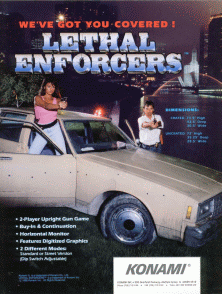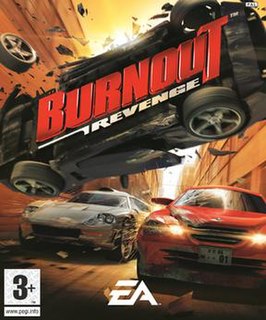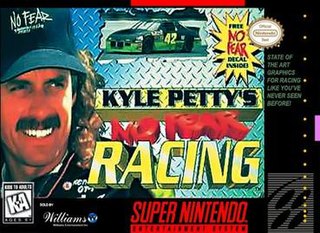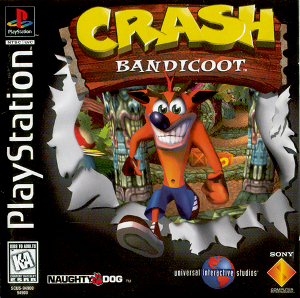
Rock n' Roll Racing is a vehicular combat-based racing video game developed by Silicon & Synapse and published by Interplay Productions for the Mega Drive/Genesis and the Super Nintendo Entertainment System in 1993. The game prominently features a number of popular heavy metal and rock songs in its soundtrack, hence the game's title. The game was ported to the Game Boy Advance in 2003.

R.C. Pro-Am is a racing video game developed by Rare. It was released for the Nintendo Entertainment System (NES) by Nintendo for North America in March 1988, and then in Europe on April 15 of the same year. Presented in an overhead isometric perspective, a single player races a radio-controlled car around a series of tracks. The objective of each track is to qualify for the next race by placing in the top three racers. Players collect items to improve performance, and they must avoid a variety of hazards such as rain puddles and oil slicks. It is an example of a racing game which features vehicular combat, in which racers can use missiles and bombs to temporarily disable opposing vehicles. Originally titled Pro Am Racing, R.C. Pro-Am was also ported to the Sega Genesis in 1992 as Championship Pro-Am, an enhanced remake with enhanced graphics and additional features. R.C. Pro-Am was followed by two sequels: Super R.C. Pro-Am in 1991, and R.C. Pro-Am II in 1992.

Virtua Racing or V.R. for short, is a Formula One racing arcade game, developed by Sega AM2 and released in 1992. Virtua Racing was initially a proof-of-concept application for exercising a new 3D-graphics platform under development, the "Model 1". The results were so encouraging, that Virtua Racing was fully developed into a standalone arcade title. Though its use of 3D polygonal graphics was predated by arcade rivals Namco and Atari, Virtua Racing had vastly improved visuals in terms of polygon count, frame rate, and overall scene complexity, and displayed multiple camera angles and 3D human non-player characters, which all contributed to a greater sense of immersion. Virtua Racing is regarded as one of the most influential video games of all time, for laying the foundations for subsequent 3D racing games and for popularizing 3D polygonal graphics among a wider audience.

Crash Team Racing is a kart racing video game developed by Naughty Dog and published by Sony Computer Entertainment for the PlayStation.

Street Racer is a racing video game published by Ubisoft for various systems. It was released for the Super Nintendo Entertainment System in 1994, Sega Mega Drive in 1995, PlayStation, Sega Saturn and Game Boy in 1996 and PC and Amiga in 1997. Marketed as a "cross between Mario Kart and Street Fighter", the go-kart themed game combined racing with comedy and beat 'em up influenced violence. The game was a success on the SNES and Mega Drive and received mixed reviews across platforms.

Burnout is a racing video game developed by Criterion Games and published by Acclaim Entertainment for the PlayStation 2, GameCube and Xbox.

Lethal Enforcers is a 1992 shooting game released for the arcades by Konami. The in-game graphics consist entirely of digitized photographs. This caused controversy as it allowed players to shoot photorealistic representations of enemies.

Crash Nitro Kart is a racing video game developed by Vicarious Visions and published by Universal Interactive. The Game Boy Advance, GameCube, PlayStation 2, Xbox versions were released in North America on November 11, 2003 and in Europe on November 28, 2003; The N-Gage version of the game was released in Europe on June 30, 2004 and in North America on July 28, 2004. The Mobile version was released on September 20, 2004. The PlayStation 2 version was re-released in the three-disc "Crash Bandicoot Action Pack" compilation in the United States on June 12, 2007 and in Europe on July 20, 2007. It was the last Crash Bandicoot game released under the Universal Interactive label, which parent company Vivendi Universal Games would scrap after the release of this game.

Need for Speed II is a racing video game released in 1997. It is a part of the Need for Speed series and is the second installment, following Road & Track Presents: The Need for Speed.

Burnout Revenge is a racing video game developed by Criterion Games and published by Electronic Arts for PlayStation 2, Xbox and Xbox 360. Burnout Revenge was also dedicated to the memory of Rabin Ezra, who died on 27 June 2005.
The Incredible Crash Dummies is a line of action figures designed by David McDonald and Jim Byrne, styled after the eponymous crash test dummy popularized in a public service advertising campaign of the late 1980s, to educate people on the safety of wearing seat belts. The toys were first released by Tyco Toys in the early 1990s and discontinued in 1994. From 2004 on, a new series of animated shorts involving the crash dummies was produced and the action figures subsequently revived under the Hot Wheels brand, another subdivision of Mattel.

Kyle Petty's No Fear Racing is a stock car racing video game for the Super NES that was released in 1995.

Ridge Racer is a 1993 racing video game developed and published by Namco. It was initially released on the Namco System 22 arcade system board, and later ported to the PlayStation console in 1994. It is the first title in the Ridge Racer series released for arcades and home consoles. The objective is to finish in first place in a series of races. The PlayStation version supports Namco's NeGcon controller.

Road & Track Presents: The Need for Speed is a 1994 racing video game, released on the 3DO and ported to MS-DOS, Windows, PlayStation and Sega Saturn. It is the first installment released in the Need for Speed series. The premise of the game involves racing in sport cars, including several exotic models and Japanese imports.

Crash Bandicoot is a platform video game developed by Naughty Dog and published by Sony Computer Entertainment for the PlayStation. The game was released in North America in September 1996, and in Europe in November 1996.

Michael Andretti's Indy Car Challenge is an arcade-style racing video game that is sponsored by Michael Andretti. It was released exclusively for the SNES in North America and Japan.

Skitchin' is a video game for the Sega Genesis, developed by EA Canada and published by Electronic Arts in 1994. The game puts the player in control of an inline skater who has to ride his inline skates while holding onto cars, bikes, and trucks. Players have this character defending and attacking computer-controlled opponents while racing to the finish. Winning races earns the player's character money. The game has a similar design structure to other video games such as Road Rash. Following its release, it received generally negative reception.

Way of the Warrior is a fighting game developed by Naughty Dog and published by Universal Interactive Studios for the 3DO in 1994. The game was released in North America on August 30, 1994, and in Japan on May 26, 1995.

Road Rash is a 1991 racing video game originally developed and published by Electronic Arts (EA) for the Sega Genesis. It was subsequently ported to a variety of contemporary systems by differing companies. The game is based on a series of road races that the player must win to advance to higher-difficulty races. It is the debut installment in the Road Rash game series.






















